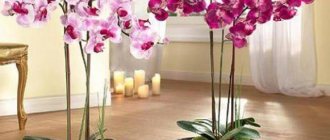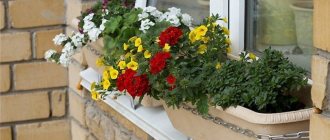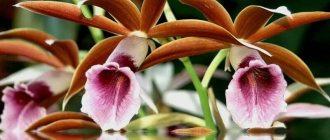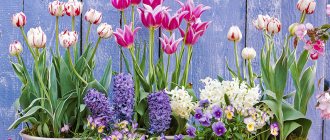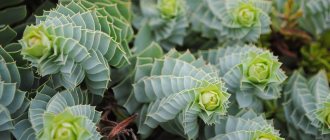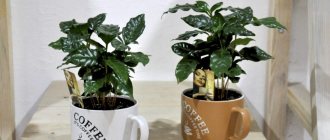Orchids, as well as Yartyshnikov plants (popularly called orchids) belong to the ancient family of the Late Cretaceous era. They grow on all continents, with the exception of Antarctica. Wild species make up about 10% of all plants in the world. These flowers are abundant in the tropics, as they thrive in a climate with a short dry season and high rainfall throughout most of the year. Some of them are unpretentious and can be grown at home.
Beautiful varieties of orchids for apartments and houses
Orchids are traditionally grown in China and Japan. In these countries, they are considered real long-livers and are passed on by inheritance. Plants with somewhat strange, delightful flowers appeared in the greenhouses of Europeans, and then on the windowsills of city apartments. Some of the hardiest varieties that even a novice gardener can grow:
- Dendrobium Nobile is a relatively short (up to 60 cm) plant with fragrant orange, white, red or purple flowers. For good growth, a lighted place is necessary, but it should not be exposed to direct sunlight;
- Cattleya - in orchids of this genus from South America, the diameter and shape of flowers can vary, on average from 5 cm to 25 cm. In nature, they can be found both on tree trunks and branches, and in rock breaks. It has a sympodial structure and grows in breadth. The flowering period is autumn or winter, lasting about a month. National symbol of Colombia;
- Oncidium, or tiger orchid. Small yellow or red-brown flowers. Easily adapts to home conditions. The optimal air temperature is 16-22°C. Blooms for 6-8 weeks. If the peduncle is removed, the plant will send out shoots and flowers will appear again.
Breeders annually develop new varieties that are easy to grow at home. Hobbyist orchids usually choose hybrids that do not have high temperature requirements.
Phalaenopsis in the wild
The phalaenopsis that we see on store shelves are artificially bred hybrids, whose distant wild ancestors grow in the tropical rainforests of Southeast Asia. The genus phalaenopsis (meaning “butterfly-like”) has about 40 wild species and many man-made hybrids. The name of these orchids was given by the director of the Leiden Botanical Garden, Karl Blume, in 1825. While on one of the islands of the Malay Archipelago, at dusk he looked at the jungle through binoculars and mistook a cloud of white orchid flowers swaying in the wind for a flock of flying moths.
In the wild, phalaenopsis prefer moist, shaded areas above swamps, streams and rivers with consistently warm temperatures ranging from 19 to 27 degrees without significant changes between winter and summer. They live on the branches and trunks of trees, entwining them with their tenacious aerial roots. Water is obtained thanks to these same aerial roots, absorbing it from rain, morning fog and very humid air. Nutrients for phalaenopsis are rotten plant debris stuck in the bark. Orchids do not parasitize on trees, do not drink juices from them and do not cause any harm to them - the tree is only a support for the orchid, which gives it the opportunity to rise higher towards the light in the conditions of a dense tropical forest. Epiphytic (tree-living) plants are not only orchids, but also, for example, bromeliads, popular in indoor floriculture.
Who is the orchid next to in the interior of the apartment?
There are no particular difficulties in determining suitable neighbors for orchids. The main thing is that the growing conditions for everyone are the same, the same:
- demands on lighting;
- temperature regime;
- humidity level in the room.
You cannot place newly purchased orchids next to indoor roses, citrus fruits, or coffee trees. The purchased plant may be infested with mealybugs, spider mites or scale insects (these can be dangerous). You should create an incubation period for the orchid, carry out disinfection, and only then determine a place on the windowsill and choose neighbors.
It is generally accepted that these exquisite flowers do not grow well near citrus fruits and other aromatic plants. Thus, anthurium stops blooming in close proximity to orchids. Fruits lying in a vase can have an unfavorable effect on them. But a wide variety of indoor flowers and plants allows you to choose the best combination, exclude uncooperative ones and select companion plants.
As a table decoration
An exquisite orchid can decorate a festive table. This could be a cut flower in a vase or a small pot. It is imperative to ensure that it is completely dry and clean, and it is better to decorate the ground so that it is not visible at all.
The way you decorate your interior with orchids will only highlight your individuality. But, undoubtedly, orchids will create a unique atmosphere of lightness and purity.
In the following video, florist designers offer compositions from various varieties of orchids for your interior.
Comfort to your home! If you liked the article, share it with your friends by clicking on the icon of your social network. Thank you! Join the discussion!
We would be interested to know your point of view, leave your opinion in the comments
